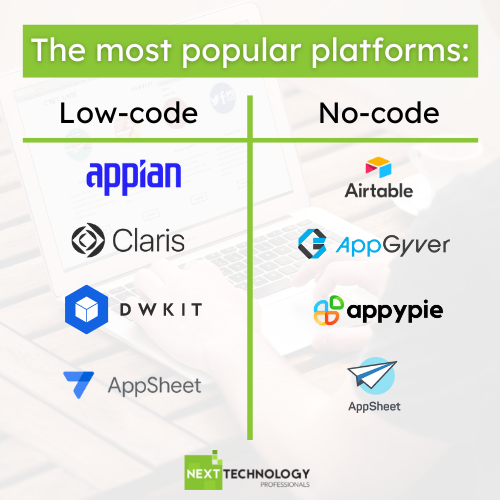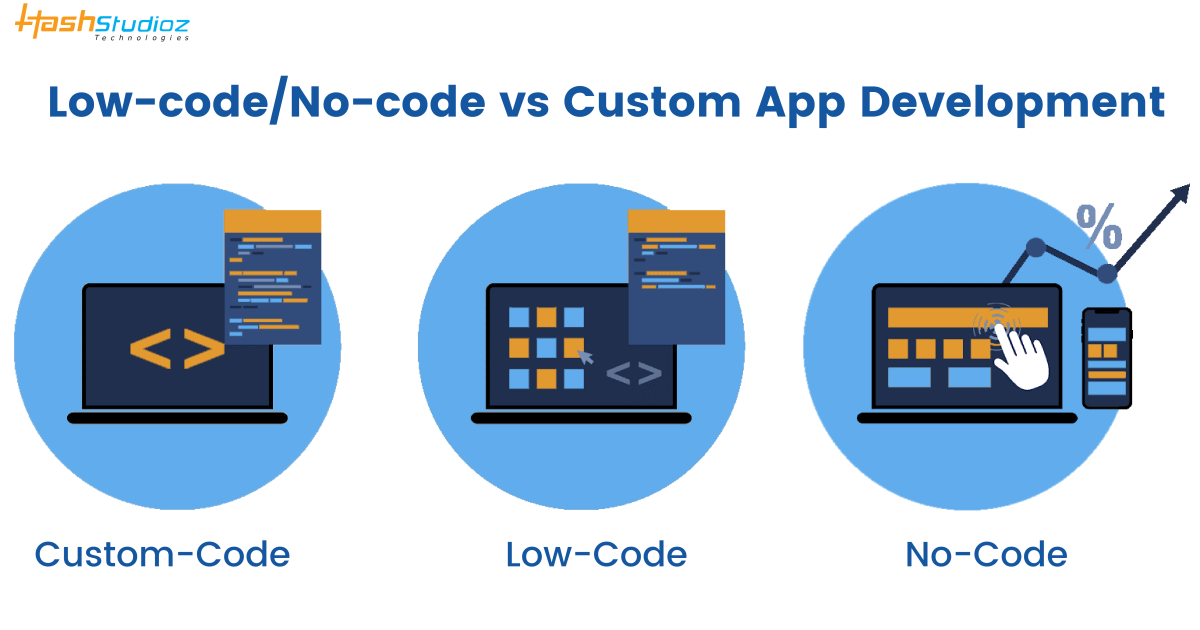Good Facts To Deciding On Low-code platforms for application development
Good Facts To Deciding On Low-code platforms for application development
Blog Article
Benefits Of Developing Applications Using Low-Code With Regard To Accessibility To Non-Developers
Due to a number of important factors, Low-Code Application Development is a possibility for non-developers. They are also known as "citizen designers."
Drag-and-Drop Builders: Low-code platforms offer drag-and-drop interfaces which allow non-developers to create applications visually without needing to write code. This makes it much easier for people who don't have technical expertise to be involved in the development process.
WYSIWYG editor: "What you see is the result you will get" editors allow users to design interfaces, workflows, and other features in a manner that is similar to the final product. They are simpler to understand and to make use of.
Simple design of Workflow and Logic
Visual Workflow Design: Users can quickly design business processes and application logic using diagrams, flowcharts and models. They are simpler to use than traditional coding.
Pre-built Logic components Low-code platforms have logic components that have been already built (e.g. conditional loops and statements) and can be easily customized which eliminates the need for complicated coding.
Templates and components that are reuseable:
Libraries of prebuilt templates Low-code platforms often provide templates libraries for various types of application. This gives non-programmers the ability to begin with a solid base and customize it as required.
Reusable Widgets and Modules: With the help of the reuse of modules and widgets users can simplify the design process while reducing their requirements for technical expertise.
Guided Development and Tutorials:
Step-by-Step Instructions: Platforms typically offer a set of development guides along with tutorials and guidelines to assist novice developers in building applications.
Interactive Tutorials Interactive tutorials and hands-on ones let users learn by doing. They gain confidence by making use of the platform.
Integration with existing tools:
Easy Integration: Low-code platforms are built to easily integrate with the existing business tools and systems (e.g. CRM, ERP) and allow non-programmers to create applications that work with their existing workflows.
APIs/Connectors: The built-in APIs/connectors allow non-developers to connect their applications to other services.
Collaboration Features:
Team Collaboration Features, like real-time collaboration as well as shared workspaces, allow professionals and non-developers to work together efficiently.
Role-based Access Control: You can give non-developers certain roles that have the right access level, so that they can participate in the development process while not compromise on security or function.
Automated Tests and Debugging
Low-code platforms are often equipped with debugging and testing software that can automatize these procedures. This makes it much easier for non-developers to ensure that their applications function correctly.
Error Highlighting: If problems arise the platform flags errors and suggests fixes, guiding non-developers through troubleshooting procedures.
Low-code development is more accessible to non-developers because it allows for democratization of the development process. Platforms with low-code enable business users with an intuitive, visually and logical tools. They can then actively contribute to the development and maintaining applications. Check out the top rated click here for Low-code Platform for application development for website recommendations including azure sql, cross platform mobile app development, driver jdbc, push notifications android, develop web application, azure sql server, application modernisation, cross platform mobile dev, driver jdbc, application modernization software and more.
Benefits Of Low-Code Application Development In Governance And Security
Low-code applications offer a number of advantages in terms of security and governance. These are essential for ensuring that the application is compliant as well as secure and properly managed throughout their lifespan. Here are some of the key benefits.
Unified management console: Low-code platforms typically provide a centralized administration console from which administrators can manage all applications and ensure consistent governance within the company.
Role-Based Access Control: These platforms offer robust role-based access control that lets administrators define rules and then enforce these policies. Only authorized users are permitted to modify and access certain parts of the application.
Compliance and Regulatory Adherence
Many low-code platforms include built-in compliance functions. They are designed in accordance with industry standards, regulations and laws (e.g. HIPAA, GDPR). They offer frameworks and instruments to ensure that applications comply with specifications.
Audit Trails: Organizations often use comprehensive log and audit trail systems, which enable the organization to monitor changes make, track access and assure compliance with both internal and external regulations.
Improved Security Measures
Data Encryption Low-code platforms typically have built-in encryption for data in transit and at rest, protecting sensitive information.
Security Certificates: A lot of low-code companies have a security certificate (e.g. ISO 27001 and SOC 2) which demonstrate they adhere to the strictest security standards. They offer an additional security level to their customers.
Automated security updates:
Regular patching and updates: Low-code platforms handle most security patches and updates automatically. They make sure that applications are safe from the most recent attacks without requiring developers to intervene manually.
Security Monitoring - Continuous monitoring of security is typically part of the program. It provides real-time insight and alerts about security risks that could be a threat.
Data Governance
Data Access Policies These platforms allow organizations to establish and implement their data access policies and ensure only authorized users have access to information and that it's being used appropriately.
Data Masking and Anonymization: Inbuilt tools for masking data and anonymization help protect sensitive data, particularly in the testing and development environment.
Consistent Lifecycle Management of Applications
Pipelines for Development and Delivery: Low-code platforms typically include integrated development pipelines and delivery pipelines that include security checks. Security is assured throughout the lifecycle.
Version Control. Integrated version management helps to track and reverse any changes made to the application, while ensuring that its integrity is preserved.
Authorization, User Authentication and Authorization
Single Sign On (SSO) Single Sign On (SSO): Single sign-on and other advanced authentication techniques reduces the burden of managing users and increases security.
Multi-Factor Authentication Most platforms can support multi-factor Authentication, which adds an extra layer to security when logging into applications.
Policy Enforcement Monitoring and Compliance:
Policy Templates: Low-code platforms often include pre-defined policy templates that help organizations quickly establish security and governance policies.
Compliance Monitoring Tools: These tools provide regular monitoring and report on compliance status, making it easier to recognize and resolve any issues that could arise.
Integration with Existing Security Infrastructure:
Integration seamless: Low-code platforms can easily be integrated into the existing security tools and devices like firewalls, SIEM products (Security Information and Event Management), and identity management systems.
API Security: Built in API security features help protect information, guarantee integrity of the application and provide safe integrations.
Training and Best Practices:
Guided Best Practices: A number of platforms offer guidelines and best methods for secure application development that help developers who are not developers to adhere to security standards.
Security Training: Certain low-code providers offer security training and tools to help users learn how to create and maintain secure applications.
Overall, governance and application security features ensure that applications will be developed and maintained in a secure manner and in accordance with regulations and under control. These platforms include the tools and frameworks required to supervise and control process of developing applications, and secure sensitive data, while ensuring legal compliance and enforcing the policies. Have a look at the top Legacy application modernization with Low-code for more advice including rad development, low code platforms, develop web app, database in azure, ms azure sql, lowcode no code, develop cross platform mobile app, rapid applications, developing mobile apps, paas service and more.
Benefits Of Low-Code Application Development In Terms Of Customization And Limitations
Low-code design for applications is an equilibrative, flexible method that overcomes the limitations of the system and allows for customisation. These are the key advantages: Managing limitations
In overcoming Complexity Barriers:
Low-code platforms facilitate development by providing pre-built templates and components. This facilitates quicker deployment and development of complex applications.
Many platforms feature guided workflows, which assist developers navigate through complicated procedures. They minimize the risk of error and maintain uniformity.
Scalability Solutions:
Built-in Scalability: Low-code platforms come with a variety of features that allow for the design of scalable architecture, which allows applications to cope with increased loads without major redevelopment.
Performance Monitoring Tools: Instruments for monitoring and enhancing performance are built into the application to make sure it remains efficient even as it scales.
Security and compliance
Integrated security features of Low-code comes with built-in measures of security, such as encryption. Access control based on role and automated compliance check address the most frequent security concerns.
Regular Updates: Platforms regularly update their security protocols and security measures to ensure that applications remain secure against emerging threats.
Customization capabilities:
Extensibility:
Low-code platforms are often able to integrate custom code, such as JavaScript or Python, allowing developers to enhance their capabilities beyond the normal.
Developers can design customized plugins and modules with functions that can be specifically tailored to meet the needs of specific businesses.
APIs and integration:
API Support: The extensive API support allows seamless integration of services and systems from outside. This facilitates extensive customization and connectivity.
Third-Party Services: Low-code platforms usually provide pre-built connectors for well-known third-party services, making it easier to customize and integrate applications.
Flexible UX/UI:
User interfaces that can be customized: Developers are able to modify and design the user interfaces to satisfy specific branding requirements and user-friendliness requirements, creating an experience that is customized for users.
Responsive Design The built-in capabilities of responsive design guarantee that applications are able to be adapted to different devices and screen sizes.
Business Logic Customization
Visual Workflow builders: These tools allow developers build complex processes with minimal or no programming. They can design workflows and business logic using visual.
Conditional Logic & scripting: Platforms allow for the use of conditional logic, and custom scripting to manage specific business rules.
Data Management
Custom Data Modelling: Those who develop the models define custom models to fit particular requirements of the application. They can adapt the handling of data to meet business specifications.
Advanced Data Processing: Integration of advanced tools and capabilities to process data allow for customization of the way data is processed in an application.
Balancing Limitations with Customization:
Frameworks and Standards
Low-code Platforms Encourage Industry Best practices and standards: Low code platforms encourage adherence to industry-standard best practices and standards. This helps to maintain high-quality, secure and flexible applications.
Governance Frameworks. The built-in governance frameworks help ensure that any modifications are not damaging to the security, integrity or security of the application.
Iterative Design and Feedback
Rapid Prototyping. The capability of quickly prototyping and testing modifications allows developers to iterate the app based on the feedback of users. This helps refine the app in order to better meet the needs of users.
Low-code platforms facilitate continuous improvement by allowing the continuous improvement of their design and enhancements the platform as requirements of business evolve.
Users Empowerment
Low-code platforms empower citizen developers by allowing non-developers by using intuitive interfaces to modify applications, they expand the pool contributors that can improve and customize applications.
Training and Support: Many platforms have extensive resources for training and support that can assist users with making efficient customizations without compromising the stability of the application or performance.
Low-code development is an effective framework that allows for plenty of customization while addressing any issues. This balance allows companies to build and maintain apps that function and adapted to specific business needs. While maintaining high quality, security, scalability, and standards.